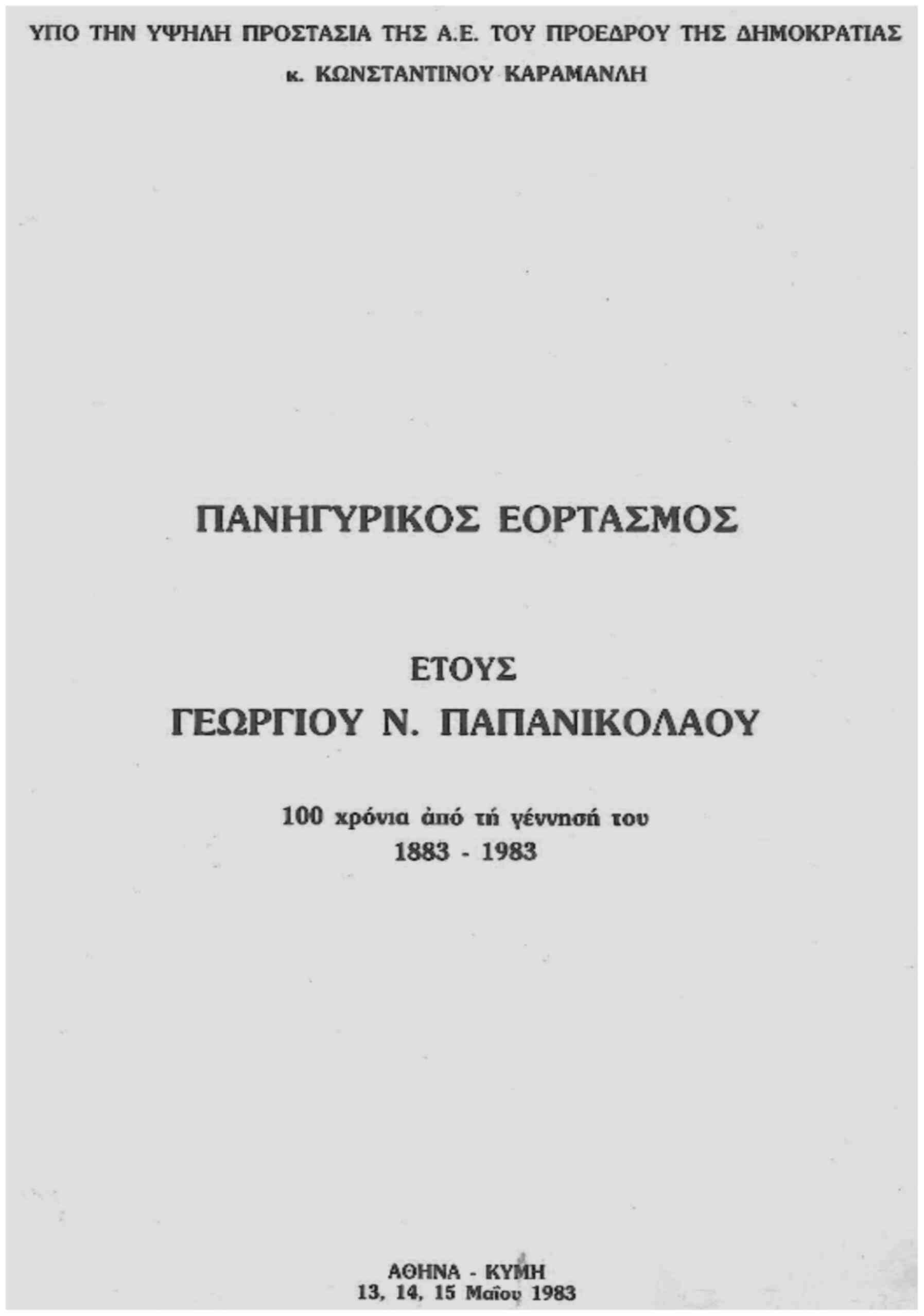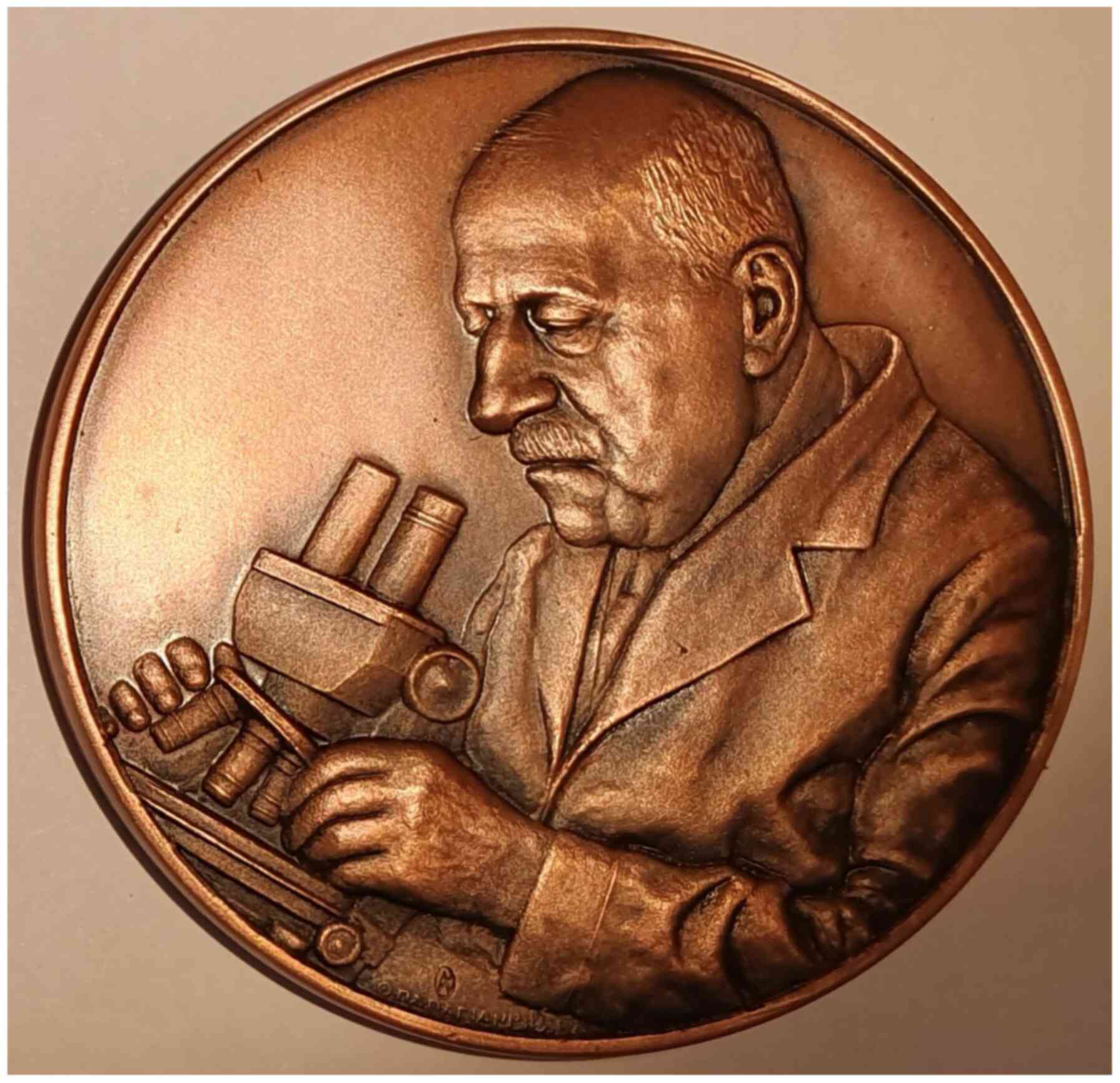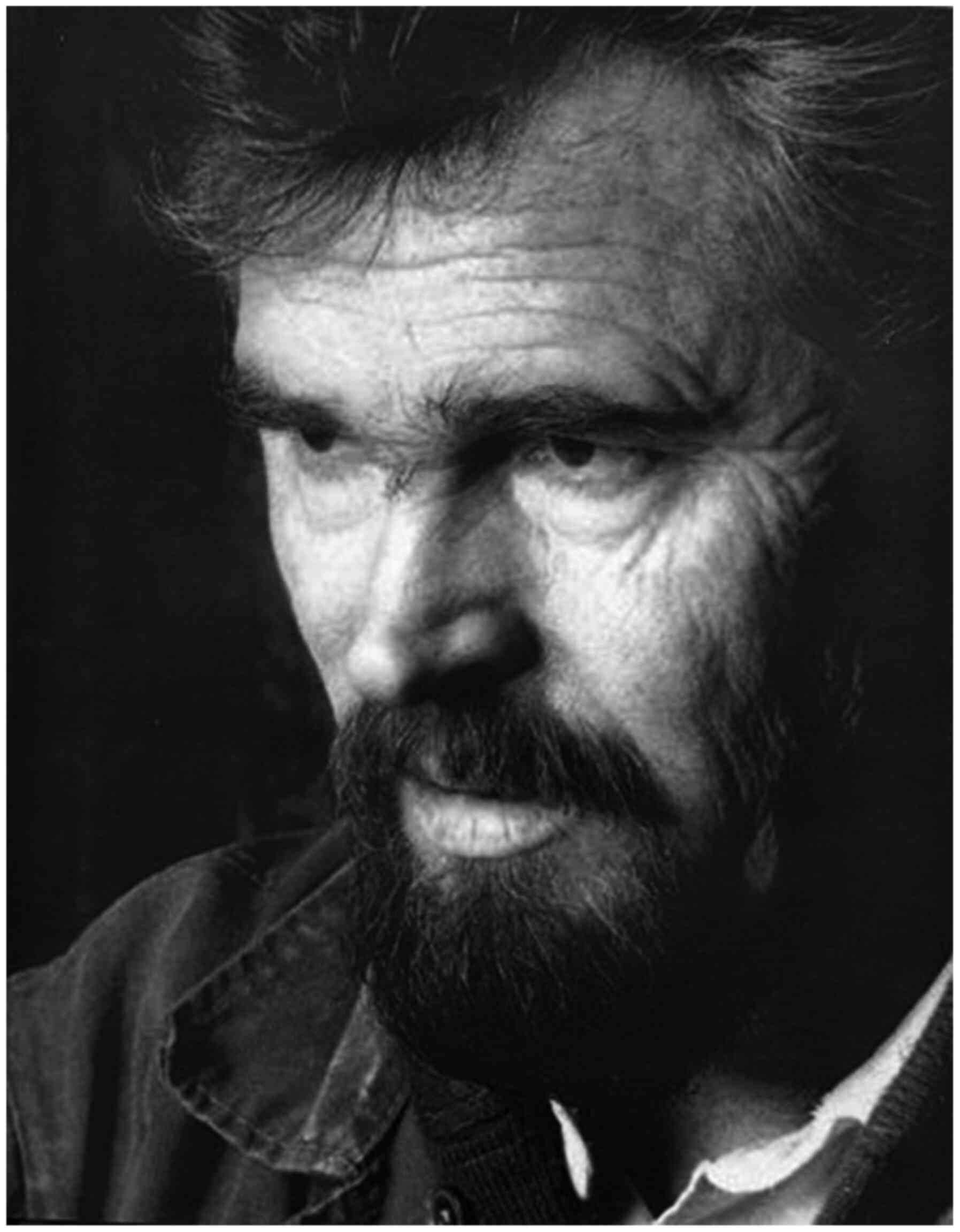1. Introduction
Dr George N. Papanicolaou, who was born on the
island of Euboea (Cyme, May 13th 1883), is the most significant
Greek doctor in modern medicine (1-6).
On 13th-15th May, 1983 (Fig. 1),
the Academy of Athens celebrated the 100-year anniversary of the
birth of Dr George N. Papanicolaou (6). The special ceremony was performed in
the Central Hall of the Academy of Athens in Athens (Greece) under
the auspices of the President of the Hellenic Democracy
Constantinos Caramanlis. The organizing committee of this event was
chaired by Professor of Obstetrics and Gynecology at the University
of Athens Nikolaos Louros. On the occasion of this event, the
Academy of Athens commissioned the ‘George N. Papanicolaou Medal’,
which presents Dr George N. Papanicolaou with his microscope
(Fig. 2). The imprinting of the
face of Dr George N. Papanicolaou on this medal is considered as
one of the most successful, accurate and detailed sculpture
presentations of the great doctor among all the existing sculpture
works on Dr George N. Papanicolaou, worldwide. The medal was brass
and it was created by Professor Theodoros Papagiannis, Assistant
Professor of Sculpture, at that time, at the Athens School of Fine
Arts in Athens (Greece). A copy of this medal is located at the
‘Museum of Contemporary Sculpture Theodoros Papagiannis’ in
Elliniko, Ioannina (Greece), as well as at the newly founded
Institute of Paediatric Virology based on the island of Euboea,
birth place of Dr George N. Papanicolaou.
Born in 1942 in Elliniko, Ioannina (Greece),
Professor Theodoros Papagiannis (Fig.
3), Professor Emeritus of Sculpture at the Athens School of
Fine Arts is one of the most well-known modern Greek sculptors. He
studied Fine Arts at the Athens School of Fine Arts next to Yiannis
Pappas from 1961 to 1966, while in 1967 he studied ancient Greek
Art and the Art of the Mediterranean Basin (7). He became Assistant Professor at the
Athens School of Fine Arts in Athens, Greece, in 1970, while during
1981-1982 he attended the ‘École nationale supérieure des arts
appliqués et des métiers d'art’ in Paris, France. In 1987, he was
elected Associate Professor at the Athens School of Fine Arts.
After retiring, in 2009, he founded the ‘Museum of Contemporary Art
Theodoros Papagiannis’ in Elliniko, Ioannina (Greece).
Today, Professor Papagiannis is Professor Emeritus
of Sculpture in the School of Fine Arts and Professor Emeritus at
the University of Ioannina in the Department of Plastic Arts. His
work includes busts and statues of prominent personalities, medals,
coins and large sculptural compositions. His sculptures stand in a
number of public locations in Greece and abroad, and are held in
public and private collections of museums and galleries, including
the National Gallery of Greece and the Presidential Palace in
Athens (Greece). One of his most significant works is his sculpture
‘The Runners’, which was installed at O'Hare International Airport
in Chicago (USA) in April 2011; the sculpture is 4.9-m-high and
12-m-long, and consists of ten individual statues of runners made
of stainless steel approximately 57-mm-thick. He has organized
various sculpture symposiums in Greece and Cyprus, and has
cooperated with many European Fine Arts schools, particularly the
Academy of Arts in Berlin (Germany) and the Brera Academy in Milan
(Italy). To date, he has been awarded with many prizes in different
competitions that he has participated. In 2015, he was honored by
the President of the Hellenic Republic Mr. Carolos Papoulias with
the Grand Commander of the Order of the Phoenix, while in 2017, the
‘10th High School of Ioannina’ was named after Theodoros
Papagiannis. Recently, in 2019, he received by the Academy of
Athens the Silver Medal of the Order of Letters and Arts. He lives
and works in Athens, Greece. In the context of the forthcoming ‘6th
workshop on paediatric virology’ organized by the Institute of
Paediatric Virology (IPV) based on the island of Euboea (8), Professor Theodoros Papagiannis will
provide an honorary lecture on ‘the challenge of creation in art
and science’.
2. Questions and Answers
Question:
Professor Theodoros Papagiannis, you are the creator
of the ‘George N. Papanicolaou Medal’ by the Academy of Athens in
1983 for the 100-year anniversary of the birth of Dr George N.
Papanicolaou. Could you tell us about the story of this medal?
Answer:
The ‘George N. Papanicolaou Medal’ was created in
1983 and was commissioned by the Academy of Athens on the occasion
of the 100th anniversary of the birth of ‘George N. Papanicolaou’.
Professor Nikolaos Louros, Emeritus Professor of Obstetrics and
Gynecology at the University of Athens School of Medicine and
Member of the Academy of Athens at that time, had asked me to do
so. Professor Nikolaos Louros, who in 1973 had served as president
of the Academy of Athens, was the son of the famous Greek physician
and politician of the last century, Konstantinos Louros. I remember
that when I finished the medal, I presented it to Professor
Nikolaos Louros at his house. He liked it very much and the only
remark he made was about the microscope, which in the medal is
depicted in front of George N. Papanicolaou. ‘This is the old
microscope!’ he told me. ‘We have to present the newest microscope
in the medal!’ However, on the photo I worked, Dr George N.
Papanicolaou had the old microscope in front of him and I must say
that I liked it more for the composition of the medal. Eventually,
I created a second variant with the newest microscope and finally
this became the base for the medal. The medal was printed in
several copies, which were given to the honored guests of the
event. It was brass and I have two copies in my collection in
Ioannina; with great pleasure I would like to donate one of them to
your newly founded Institute of Paediatric Virology, based on the
island of Euboea, homeland island of George N. Papanicolaou.
Question:
Thank you very much for this; This is a great
honour, indeed! What style did you follow in this medal? What
process does a sculptor follow when he is called upon to capture a
particular human form?
Answer:
The style I use is the ancient Greek style. I work
negatively; that is, I make the disc in plaster, I design the
composition and I start carving by removing material. I work
negatively, I press clay and I see positively what I do and where
it needs correction. This is repeated many times until I reach the
final stage. I cast plaster on this model and take out the positive
model and send it to the pantographer. There, they make the
silicone model hard because the special pantograph machine will
record all the details. A second needle records a reduction in
steel next to the final matrix where the medals will be pressed.
The plaster sample is in a special display case in the museum I
created in Elliniko, Ioannina in Greece.
Question:
In this medal, the imprinting of the face of Dr
George N. Papanicolaou is considered to be as one of the most
particularly successful, accurate and detailed sculpture
presentations among all the existing sculpture works on Dr George
N. Papanicolaou, worldwide. What is the secret to the success of
this project?
Answer:
The secret to any work of art is the artist's design
ability and his capability to do it well. Especially the portrait
wants special skills from the artist. Ultimately, it is a matter of
the artist's talent and competence.
Question:
How much does a modern sculptor look like or differ
today from a sculptor in ancient times?
Answer:
I have already explained to you some elements of the
steps of the process that we are following today and which differ
only a little from the process that a sculptor followed in ancient
times. I have to say that we are few artists who deal with medals
and coins. It's not an easy task! You need to be concentrated on
the volume and give depth without actually having volume. You need
to adjust the volume and space so that the work looks natural
without altering the features of the face. Ancient coins are the
great teacher and some of us have studied this field a lot.
Question:
You are Professor Emeritus of Sculpture at the
Athens School of Fine Arts in Athens (Greece). Is sculpture an art,
a technique or a science? How are all these combined and
taught?
Answer:
Now you are making it difficult for me. Art, in my
opinion, is a technique and a science. Primarily, however, it is a
gift from the Muses. Their combination produces a good result,
without this being absolute. Surely, there are artists who deny
this position. Instinct and emotion, the accomplished effort have
created masterpieces that we cannot explain. Belief in a purpose or
a God often elevates things and makes them almost inexplicable with
the logical process. A work addressed to God or the Lord could not
be presented if it was not perfect, or if the artist hadn't
exhausted his potential. Things are very different today. Other
values have taken their place. Impression, easy solutions and
minimal effort dominate. We see the results. When Picasso confesses
that ‘we can't stand any comparison with the old artists’, what can
I say? This does not mean that significant projects are not being
produced today.
Question:
You mentioned earlier the ‘Museum of Contemporary
Sculpture Theodoros Papagiannis’ that you have created in your
hometown, Elliniko at the Municipality of Katsanochoria close to
Ioannina. What is this museum and how was it created? How difficult
was this task?
Answer:
The task was difficult, indeed. It could also be a
step into the void. In the cities, the museums in our country are
going through a crisis. Nevertheless, 10 years now that it is
operating, I can say that it is something important for the region.
Our actions and exhibitions have a positive response from the
public with very flattering comments. Beyond personal ambition,
which is hidden from anyone who creates a museum, the creation of
the museum in a village housed in a stone-built, rare and large
primary school, in which I attended, had multiple goals. Firstly
the decentralization, secondly the development of a region that is
slowing down, thirdly I wanted to house some projects that talk
about this place and came out of my memories and experiences. It
thus became a culture cell. Some of our actions have made it
unique. In addition to the 200 sculptures and drawings that it
houses, the 7-acre yard became a sculpture park and every summer we
invite sculptors from Greece and abroad, who create a sculpture for
our collection. We created a 5 km route from the entrance of the
village to the historic monastery of Panagia Tsouka with
sculptures. The cafes of the village are galleries decorated with
the portraits of the villagers that I have been designing for
years. The museum highlights the benefits and timeless value of
education. There is also a unique collection of medals and coins.
It was created on September 7th, 2009 - just 7 days after my
retirement from the Athens School of Fine Arts, where I was a
teacher for 39 years.
Question:
We are a group of young paediatricians who since
2007 have created the Paediatric Virology Study Group (PVSG) aiming
to study a new branch of Paediatrics, the subject of Paediatric
Virology. We would like your advice for young people, and
especially young scientists, today in Greece of the crisis.
Answer:
I would like to congratulate you for your effort and
wish you courage to continue your work successfully. I am sure you
are struggling with many difficulties! I remember three letters
from Dr George N. Papanicolaou shown to me in New York, USA, by a
Greek-American who had correspondence with Dr George N.
Papanicolaou. How bitter they were for the difficulties he had gone
through here in Greece! Until he arrived at his research center at
the Cornell University, where he remained for 47 whole years. In
our country, we often make what seams easy to be difficult. As a
teacher, what I realized for many years was the discounts we made
on education, while we were constantly talking about ‘upgrading’.
Try. Few people succeed. The majority of people are pulling down.
Follow the great Euboean Dr George N. Papanicolaou. Dr George N.
Papanicolaou shows us all the way...
Question:
Thank you for this great honor and we wish you all
the best in your art. We look forward to your honorary lecture on
‘the challenge of creation in art and science’.
Acknowledgements
This article is published in the context of the
foundation of the Institute of Paediatric Virology (IPV; https://paediatricvirology.org) based on the
island of Euboea (Greece), under the auspices of the World Academy
of Sciences (WAS) and the support of the Department of Clinical
Virology of the University of Crete School of Medicine and the
First Department of Paediatrics of the University of Athens School
of Medicine. We would like to thank all the members of the IPV for
their valuable comments and corrections.
Funding
No funding was received.
Availability of data and materials
Not applicable.
Authors' contributions
All authors (INM, CK, AP and DAS) contributed
equally to the conception and design of this manuscript, wrote the
original draft, edited and critically revised the manuscript, read
and approved the final manuscript.
Ethics approval and consent to
participate
Not applicable.
Patient consent for publication
Not applicable.
Competing interests
INM and DAS are co-founders of the Institute of
Paediatric Virology (IPV). CK and AP declare that they have no
competing interests. DAS is the Editor-in-Chief for the journal,
but had no personal involvement in the reviewing process, or any
influence in terms of adjudicating on the final decision, for this
article.
References
|
1
|
Papanicolaou G: Sex determination and sex
control in guinea-pigs. Science. 41:401–404. 1915.PubMed/NCBI View Article : Google Scholar
|
|
2
|
Papanicolaou GN and Traut HF: The
diagnostic value of vaginal smears in carcinoma of the uterus. Am J
Obstet Gynecol. 42:193–206. 1941.
|
|
3
|
Kokkori M: George N. Papanicolaou. Kedros
Editions, Athens, 2005.
|
|
4
|
Voutsa-Perdiki N: Dr George and Mache-Mary
Papanicolaou - As I knew them. Medical Council of Athens, Athens,
2016.
|
|
5
|
Mammas IN and Spandidos DA: George N:
Papanicolaou (1883-1962): Fifty years after the death of a great
doctor, scientist and humanitarian. J BUON. 17:180–184.
2012.PubMed/NCBI
|
|
6
|
Academy of Athens: A homepage to George N.
Papanicolaou 1883-1962. Academy of Athens, Athens, 1983.
|
|
7
|
Theodoros Papagiannis. urihttp://theodoros-papagiannis.gr/ensimplehttp://theodoros-papagiannis.gr/en.
|
|
8
|
Mammas IN, Greenough A, Theodoridou M and
Spandidos DA: The foundation of the Institute of Paediatric
Virology based on the island of Euboea, Greece (Review). Exp Ther
Med (In Press).
|

















